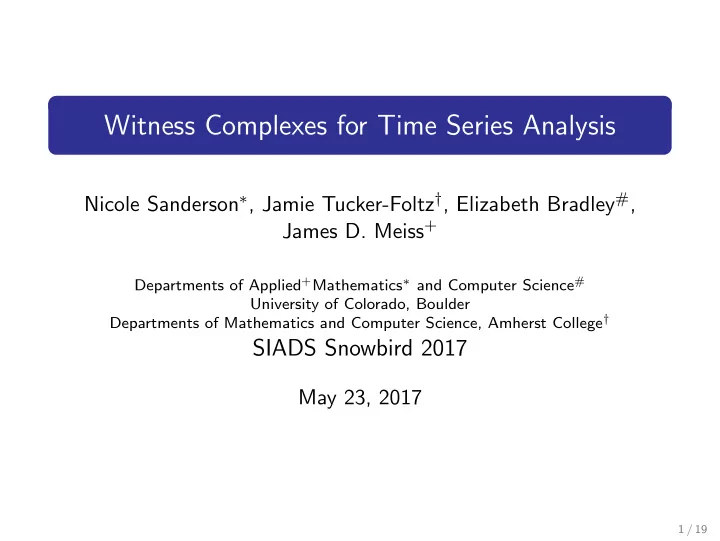

Witness Complexes for Time Series Analysis Nicole Sanderson ∗ , Jamie Tucker-Foltz † , Elizabeth Bradley # , James D. Meiss + Departments of Applied + Mathematics ∗ and Computer Science # University of Colorado, Boulder Departments of Mathematics and Computer Science, Amherst College † SIADS Snowbird 2017 May 23, 2017 1 / 19
Outline Goal: Online regime-shift detection from time series using TDA. Pipeline: 1) Receive time series 2) Delay coordinate reconstruction 3) Compute persistent homology 4) Statistics on persistence diagrams 2 / 19
Outline Goal: Online regime-shift detection from time series using TDA. Pipeline: 1) Receive time series - storage, incorporation of new data 2) Delay coordinate reconstruction - choice of delay and dimension parameters 3) Compute persistent homology - witness complexes 4) Statistics on persistence diagrams - metrics, stability 3 / 19
2. delay reconstruction 4 / 19
Delay Coordinate Reconstruction x ( t ) = ( x ( t ) , x ( t − τ ) , x ( t − 2 · τ ) , . . . , x ( t − m · τ )) Two parameters: m dimension; τ delay Theoretical bounds: m ≥ 2(box-dim) + 1; τ generic Heuristics : m estimations (False Nearest Neighbor); τ estimations (1st Minimum of Average Mutual Information) Packard et. al, Physical Review Letters (’80), Takens, Springer Dynam. Sys. and Turbulence (’81) , Sauer et. al, Journal of Statistical Physics (’91) A. Fraser et. al., Phys. Rev. A (’86) , M. Kennel et. al., Phys. Rev. A (’92) , L. Pecora et. al., Chaos (’07) 5 / 19
3. witness complexes 6 / 19
Witness Complexes for Time Series Analysis 6 4 2 0 -2 -4 -6 -6 -4 -2 0 2 4 6 Γ = { w 1 , . . . , x N } , where w i +1 = ˆ F ( w i , ∆ t i ); called witnesses L = { l 1 , . . . , l M } , some subset of the witnesses; called landmarks V. de Silva, G. Carlsson, Eurographics Symposium on Point-Based Graphics (’04) 7 / 19
Witness Complexes for Time Series Analysis w c l 1 2ε w b l 3 w a l 2 “is a witness of landmark”: w t ∈ W ǫ ( l i ) if d ( w t , l i ) ≤ d ( w t , L ) + ǫ “is a simplex in the witness complex”: σ = � l i 1 , . . . , l i k � ∈ W ǫ (Γ , L ) if ∃ w t ∈ � k j =1 W ǫ ( l i j ) . 8 / 19
Persistence Diagrams for Witness Complexes 9 / 19
4. into the pipeline 10 / 19
Test Case: Lorenz 63 50 45 m = 2 , τ = 20 40 35 30 5000 W, 100 L 25 20 15 coarse-grain topology 10 50 0 5 -20 -15 -10 -5 0 5 10 -50 15 20 20 15 10 20 15 5 10 0 5 -5 0 -10 -5 -15 -10 -20 -15 -20 -15 -10 -5 0 5 10 15 20 -20 0 500 1000 1500 2000 2500 3000 3500 4000 4500 11 / 19
Setting m = 2. 20 (a) (b) 15 15 10 10 x ( t– 2 τ ) 5 5 0 x ( t–τ ) 0 -5 -5 -10 -15 -10 m = 2 m = 3 -15 -10 x ( t ) 0 10 -20 -20 -15 -10 -5 0 5 10 15 20 5 10 15 x ( t ) -10 -5 0 -15 x ( t–τ ) Increasing the embedding dimension and tracking edge formation/destruction between landmarks showed that m = 2 is often sufficient to correctly capture the H 1 homology with a witness complex. Next: See what we can squeeze out of varying delay parameter τ . Garland et. al., Physica D (’14) 12 / 19
Some problems with standard witness complexes * τ = 6, small reach * τ = 18, high speed/low density * τ = 24, folding/projection * τ = 12, luck 13 / 19
Some observations about delay reconstruction Observation: Holes that “matter” have tangent vectors across the hole that point in opposite directions. 14 / 19
Novel Witness Complexes: Additive Penalty w , ˆ d A ( w , l ) = d E + k A · (1 − � ˆ l � ) k A = 5 penalty for opposite direction of travel! “outside-in, star-shaped” holes! maintains holes! 15 / 19
Novel Witness Complexes: Multiplicative Distortion d E d M ( w , l ) = w , ˆ 1+ k M · (1+ � ˆ l � ) k M = 10 bonus for parallel travel! “circularizes” ellipses! keeps holes open! 16 / 19
Persistence Diagrams: Additive / Multiplicative k A = 5 , τ = 6 k M = 10 , τ = 6 k A = 5 , τ = 24 k M = 10 , τ = 24 17 / 19
Final Remarks . Witness complexes are good; they reduce computation. Need to take care with time series reconstructions to get consistent topological signature. Important to have an automated method; requires metric: Wasserstein on PDs, weighted- L 2 on persistence rank functions. V. Robins, K. Turner, Physica D Nonlinear Phenomena (’15) 18 / 19
Thanks for listening! Extra thanks to Sam Molnar and Elliot Shugerman for making running code possible, and Vanessa Robins for the motivation. 19 / 19
Recommend
More recommend